The Ins and Outs of Higher Education Advertising
by Aden Andrus • February 12, 2020
Higher education advertising isn’t easy. Here at Disruptive, we’ve worked with dozens of higher education clients, and there’s no easy solution. If you don’t know what you’re doing, it’s going to be a painful, expensive ride.
However, despite all of that, there’s a reason why schools keep advertising online—it’s the best way to reach your students.
Working with our clients, we’ve seen some amazing results with higher education advertising. It is possible to drive leads and fill seats at an affordable cost. You just have to know what you’re doing.
So, to help you get your own campaigns on track, we thought we’d share some of our favorite tactics for higher education advertising. That way, you can skip some of the oh-so-expensive learning process and get to decent results faster!
Higher Education Advertising
To succeed at higher education advertising, you have to overcome a lot of obstacles. You’ve got a ton of competition, each click (let alone a lead or student) can cost a ton, and converting a click (or lead) into a paying student is often a long and difficult process.
Worse still, there are a lot of regulations that you have to work around. In addition to basic legal restrictions, you also have to deal with platform-specific restrictions on what you can and can’t say in your ad copy. For example, on Google Ads, you can’t use words like “employment”, lest you accidentally mislead a potential student into believing that your school can guarantee employment.
Is it any wonder that higher education advertising is an uphill battle? To succeed, you need to understand the different obstacles you face and how to handle them. Let’s take a look.
1. The Competition
In most competitive markets, one of the easiest ways to handle the competition is to just bid on their branded terms. It’s easy, it’s effective…and it doesn’t really work for higher education advertising.
The problem is, most higher ed institutions do a lot more online than simply advertise. If you’re a plumber, then sure, bid on the competition. If someone’s typing in a competitor’s name, they’re probably looking to hire a plumber. But if they type in the name of a competitor’s school, they could be looking for a school to attend…but they could also be a current student or faculty member.
If your ad is the first result they see, there’s a good chance that they’ll just assume that it’s a link to their school’s website. Unfortunately, you’re the one who will (literally) pay for that mistake. It’s a problem we’ve seen time-after-time in our client’s accounts. In fact, you can even see this sort of thing play out if you’re bidding on your own branded terms.
A higher ed institution isn’t like most businesses. It plays by very different rules, so if you try to approach higher ed advertising using the same tactics you see plastered across the web, you can end up spending a ton of money on the wrong clicks.
Dealing with the Competition
So, how do you deal with the competition if you can’t bid on their branded terms? The best way to deal with the competition is to create ads that stand out in some way. For example, take a look at the following:
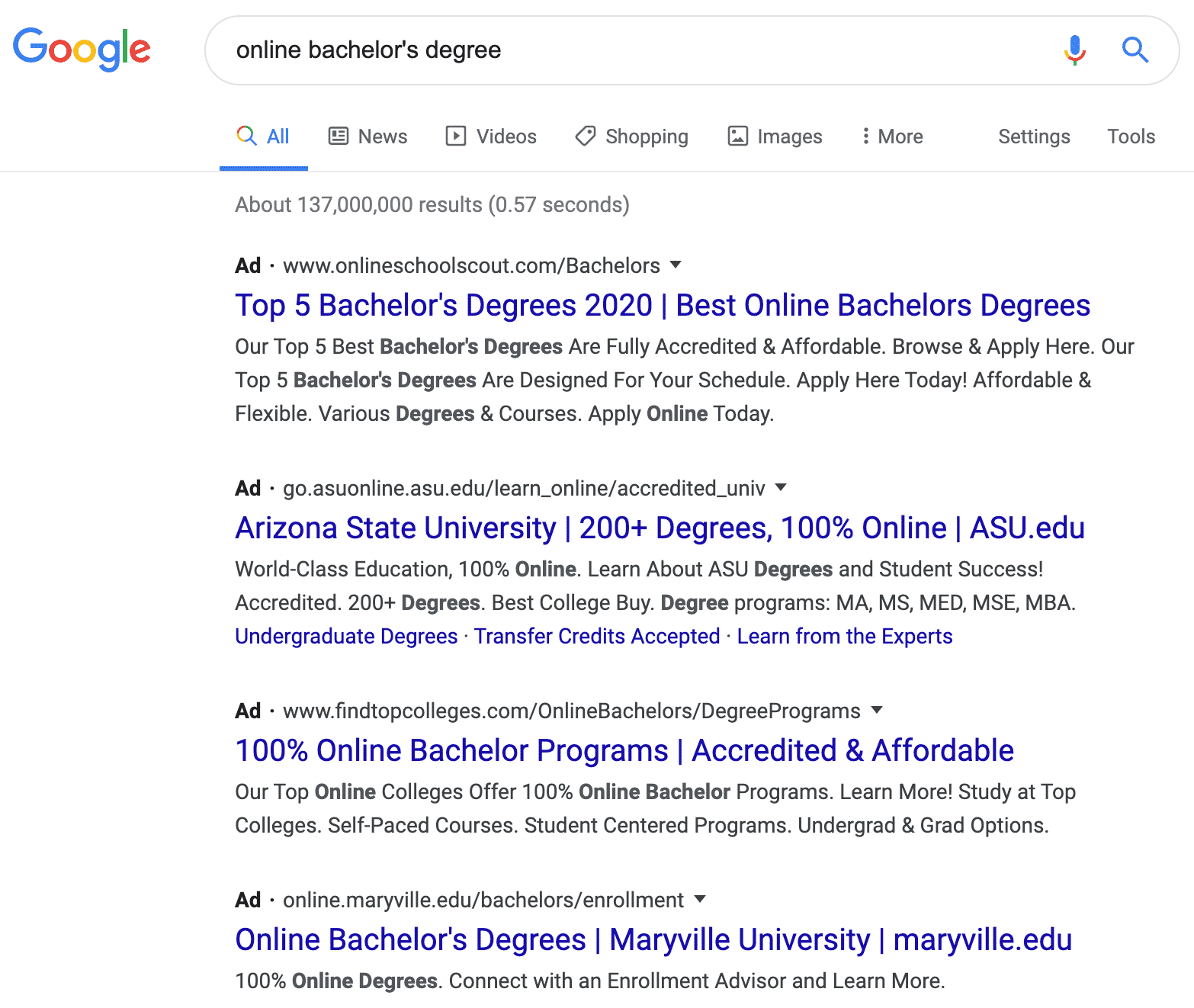
Which ad stands out the most?
Odds are, it’s probably the ASU ad. Why? It’s visually different from the other ads. Even though it sits in position #2, this ad has a lot of capital letters, the text in the title is more broken up, and it includes quick link extensions.
The difference is subtle, but when the other ads around it look almost identical, your eye naturally drifts towards what looks different.
Differentiating yourself from the competition this way isn’t nearly as fulfilling as ranking #1 on the competition’s own branded terms, but it’s a much better use of your time and money.
2. Cost-per-Click
Cost-per-click (CPC) is another huge hurdle in higher education advertising. When a single click can cost over $40, it can be really hard to run a profitable campaign.
Sadly, there aren’t a ton of great tricks for decreasing your cost-per-click. What you can do, though, is improve the quality of your clicks. A lot of the higher ed institutions we’ve worked with over the years were wasting a ton of money on the wrong clicks—and they didn’t even know it.
With that in mind, here are a few of our favorite ways to improve click quality and get more out of our clients’ budgets:
Focus Your Targeting
One of the most common mistakes we see in higher education advertising is over-targeting. To avoid missing out on potential students, higher ed advertisers target anyone and everyone who might be interested in their school. They target massive audiences on Facebook, bug the heck out of them on Instagram and add every keyword they can think of to their paid search campaigns.
But let’s be honest, this isn’t just a higher ed advertising problem. In fact, after auditing thousands of PPC accounts, we can authoritatively say that it’s one of the most common problems in paid search advertising.
In our audits of Google Ads accounts alone, we found that 94% of keywords were a complete waste of money. They never, ever produced conversions, yet they consumed 76% of ad spend.
As you can see below, businesses that spend more tend to waste less of their budget, but their performance is still pretty poor.
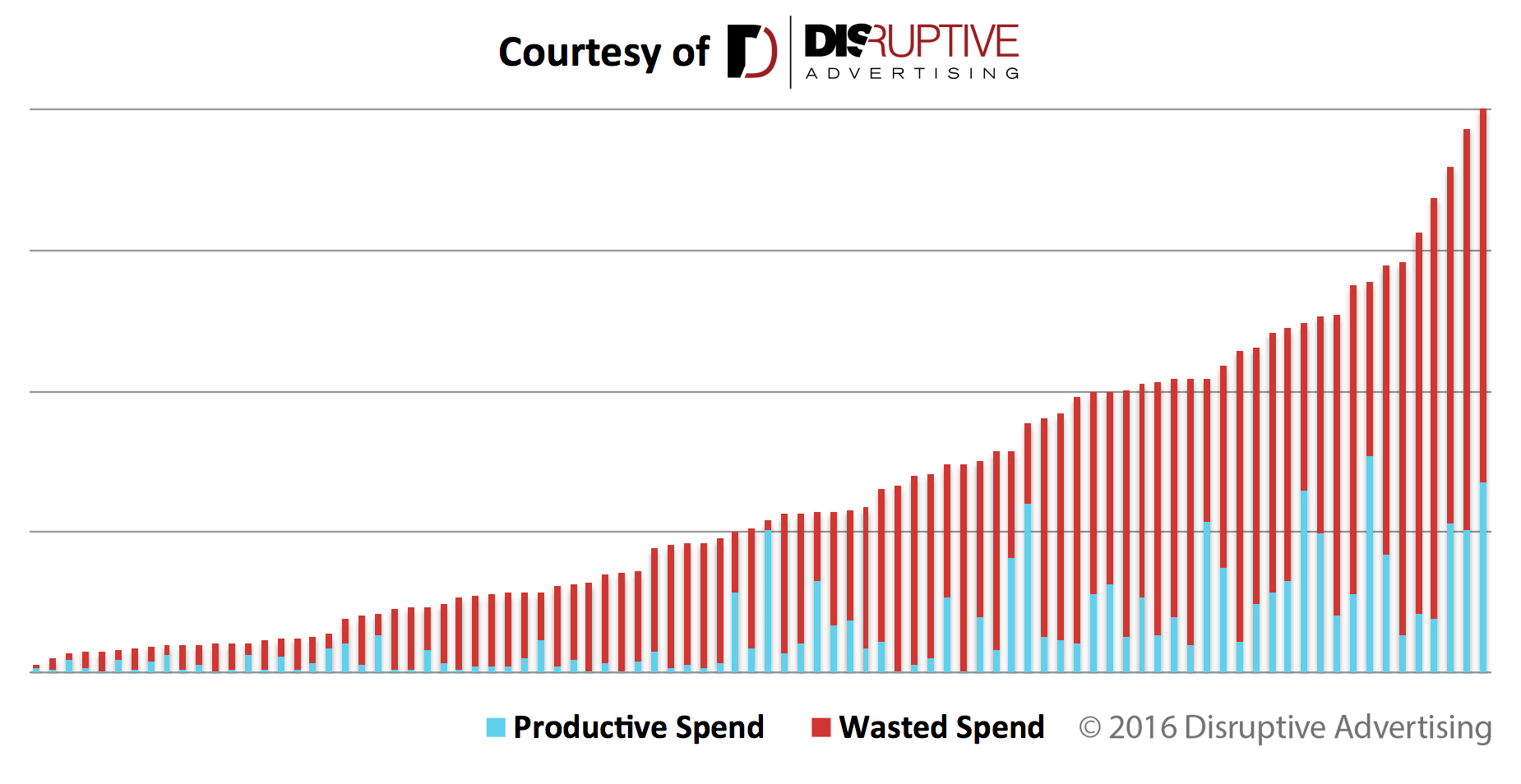
As you can probably imagine, this kind of waste has devastating consequences. In fact, in our study, we found that every 10% increase in wasted ad spend increases your cost-per-lead by 44-72%.
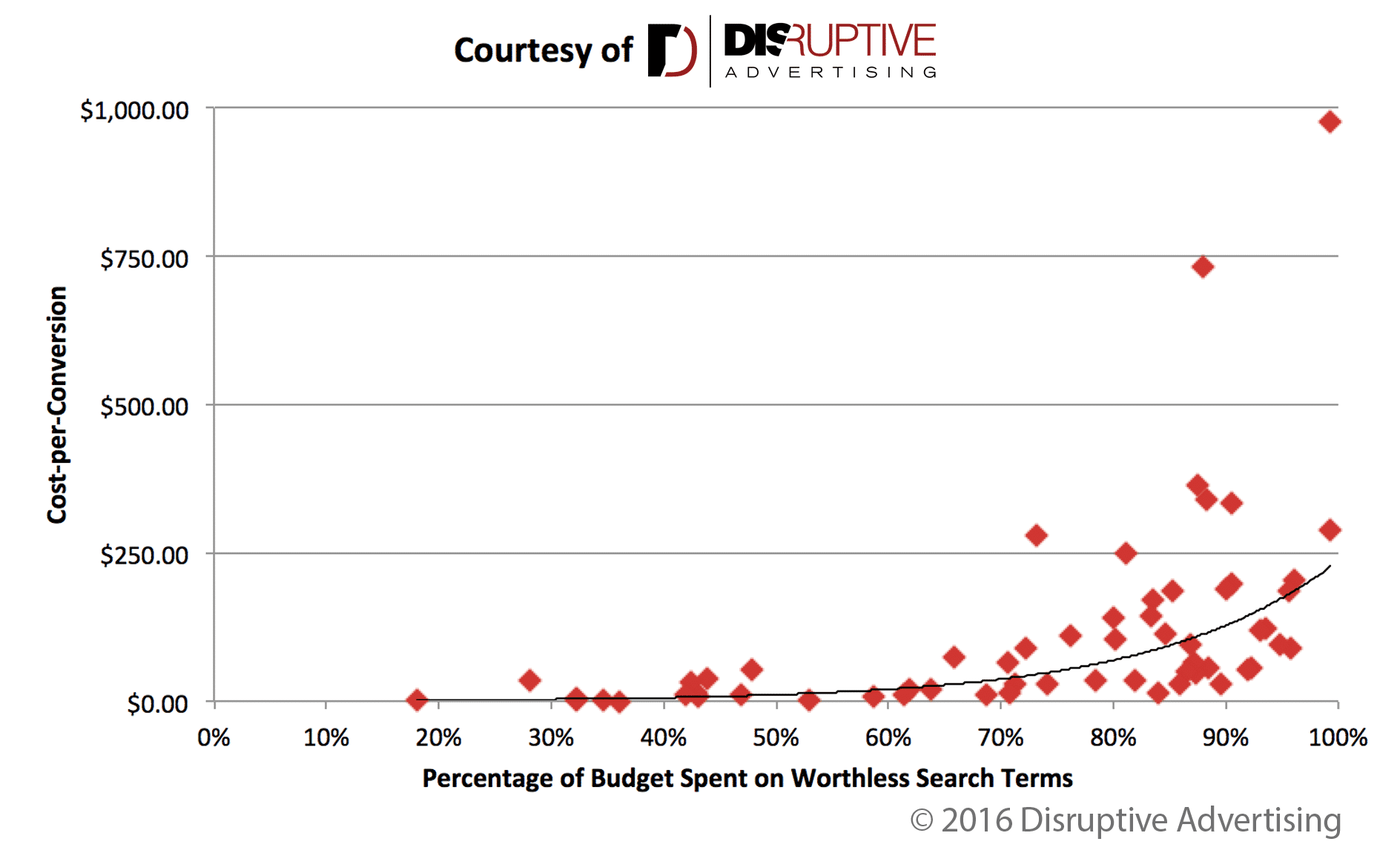
So, since most higher ed institutions are wasting around 60-80% of their budget on the wrong keywords, their cost-per-lead is usually 2-3x higher than it should be. Is it any wonder that higher education advertising feels like a losing battle?
The good new is, it’s actually fairly easy to fix this problem. If you’re like most of the schools that we work with, you could probably name your top-performing search terms without even opening Google Ads.
That’s where the majority of your ad spend should be going.
To see what percentage of your ad spend is going towards search queries that actually convert, pop into your Google Ads account and set the date range to 3-6 months. Click on the Keywords option in the left-hand sidebar and then choose the “Search terms” tab.
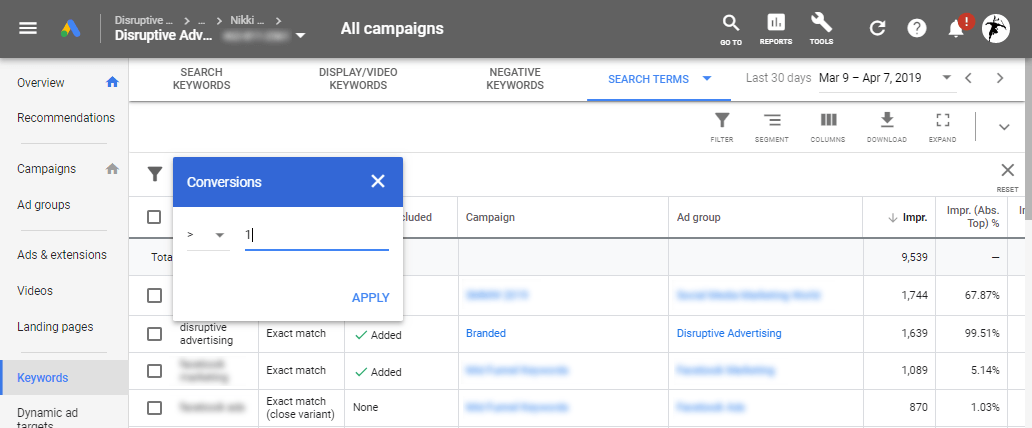
Once you’re there, click on the Filter dropdown menu and choose “Create filter.” Set your filter for “Conversions > 1” and hit “Apply” to see which search terms are actually generating leads for your school.
Of course, you can only do this if you have an effective conversion tracking system in place, but if you aren’t tracking conversions, you have much bigger problems than wasted ad spend (hard to believe, but it’s true).
Once you’ve set up your filter, you can use this report to look at a variety of information:
- What percentage of your ad spend do your top search terms account for?
- Which ad sets and campaigns are your best search terms linked to?
- Do your best search terms form the basis for specific campaigns?
- Are any of your high-performing campaigns or ads limited by budget?
- Should any of your keyword or search terms be split off from their existing campaign to form a new, more targeted campaign?
By looking at your search terms report, you can uncover exactly which queries produce value and then turn those queries into keywords for new campaigns! In fact, we once used this technique to uncover $50,000 in completely wasted ad spend for a higher education client (to learn more, check out this article).
The moral of the story? You might not be able to get out of paying through the nose for higher education clicks, but if you can focus your ad spend on the right clicks, you can still get leads and new students at a manageable price.
Get Specific
When you’re trying to get people to fill out your lead form or call your admissions department, you have to get specific. Unfortunately, many higher ed advertisers don’t understand how to use this principle in their direct-response ads.
For example, when someone searches for “online bachelor’s degree”, they aren’t thinking “I’m going to sign up for a program today.” They’re in information-gathering mode.
Running ads to people who are just looking for more information can be a great way to build brand awareness, but do that on Facebook. Don’t shell out $62 a click on Google (the current suggested bid for “online bachelor’s degree”) just to advertise to people who are simply curious.
Instead, focus most of your direct-response advertising on people who already know what they want. Unlike the “online bachelor’s degree” search, someone who searches for “nursing program” or “how to become a pediatric nurse” knows what they want. They aren’t just passively curious—they’re actively looking for a school to attend.
And guess what happens when you get specific? The competition decreases. Just take a look at the top-of-page bid recommendations for nursing program-related keywords:
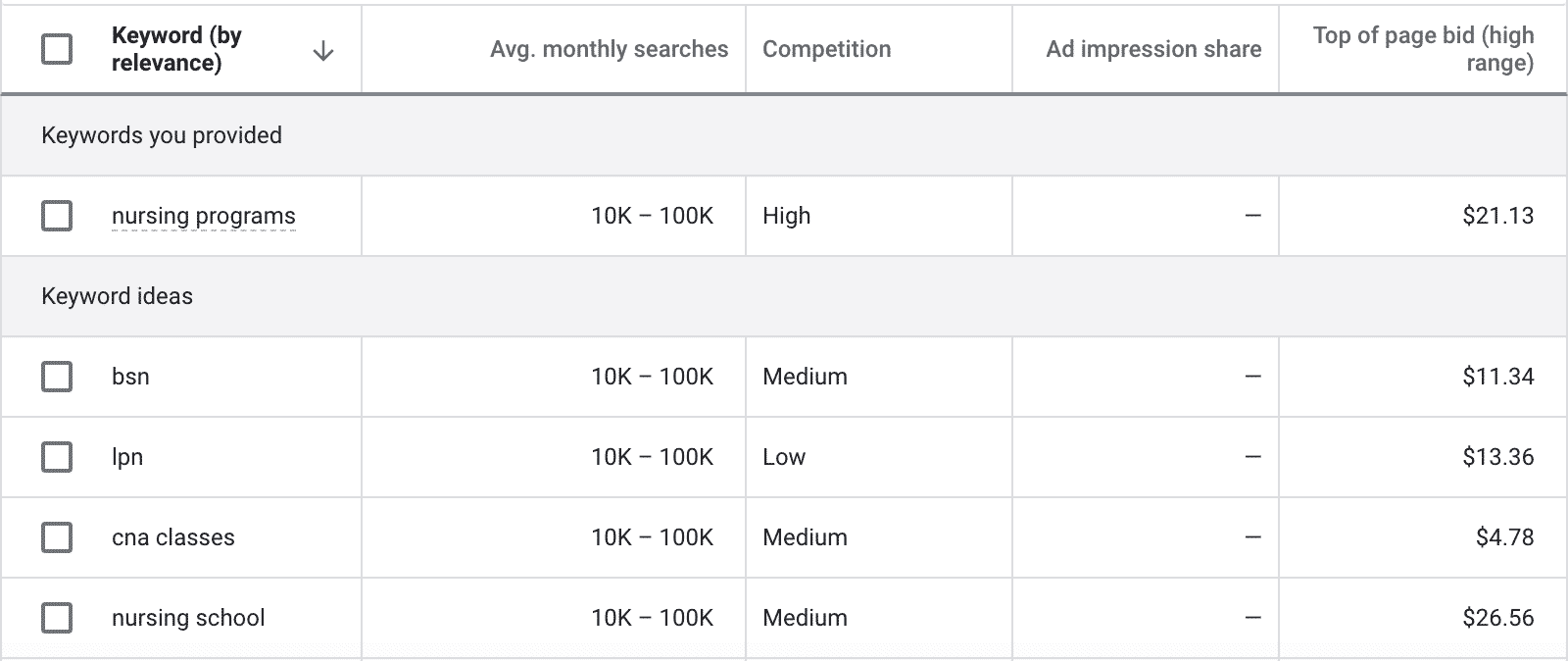
Look at that! Most of the top of page bids are less than one-third of what it costs to rank well for “online bachelor’s degree”. Higher intent with a lower CPC? Sounds like a win to me.
Now, as your direct-response strategy gets more specific, your ads will show up in front of fewer people—but that’s kind of the point. Instead of spending a ton of money on lots of really expensive low-quality clicks, you’ll be spending less and driving the kind of clicks that will actually turn into students.
Advertise on Facebook
No matter what platform you advertise on, higher education is an expensive audience to go after. However, your specific cost-per-click will vary significantly depending on the platform you are using. For example, where the average CPC on Google Ads is around $40, we frequently see CPCs of less than $2.50 on Facebook.
That being said, Facebook and Google Ads are very different.
On Google Ads, you can bid on high intent keywords like “best engineering program” that indicate specific interests and a general readiness to commit. On Facebook, you are essentially limited to top-of-the-funnel advertising.
However, while you can’t target people who are ready to sign up today on Facebook, Facebook is the ideal place to get on the radar of the sorts of people who are searching for “online bachelor’s degree” on Google.
For a fraction of the cost of a Google Ads click, you can use Facebook to warm potential students up to your higher education institution. Remember, your Facebook audience typically isn’t ready to “apply now”. Instead, they are weighing their options, which gives you the perfect opportunity to swing things in your favor.
Any good upper-funnel Facebook campaign should be designed to accomplish two objectives:
- Get people into a remarketing campaign (more about that in a second)
- Familiarize potential students with your brand
You might not get a ton of leads directly out of a Facebook campaign, but these campaigns will get people thinking about you and make them much more likely to sign up when they’re ready.
3. The Sales Process
Unfortunately, even if you know how to handle the high CPC of higher education campaigns, it’s still a long road from click to class. To really get the most out of your paid search campaigns, you need to optimize your entire sales funnel.
Remarketing
Picking a college is a big commitment, so it’s natural that most people will want to take their time. Unfortunately, if people only see your site once in their often months-long decision-making process, they’re not likely to pick you.
This is where remarketing comes into play.
Now, a good remarketing strategy will keep your name and a selling point or two in front of the people who have clicked on one or more of your ads. A truly great remarketing strategy, however, will help lead your future students along their decision-making path.
To do that, you need to craft marketing messages that match where your audience is currently at—not where you wish they were. Trying to sell too hard too soon will backfire in any higher education advertising campaign and remarketing is no exception.
Here are a couple of remarketing tactics to consider including in your strategy.
Address Their Concerns
Often, people aren’t ready to convert on your landing page because they still have unanswered questions or concerns.
They might not feel ready to commit to your college. They might think tuition is too expensive. They might feel nervous about giving you their personal information. They might not be ready to make the time commitment that comes with signing up.
Whatever the reason, if you know that many of your potential students share a common worry, remarketing can be a great way to address that concern.
For example, Southern Illinois University addresses many potential questions about what attending their university is like:
The video itself is well done, but what makes it a great retargeting ad is the message it sends to potential students who want a great college experience.
Offer an Incentive
Often, as a college or university, it may seem like your hands are a bit tied when it comes to incentivizing potential students. After all, you can’t exactly offer “half off your first semester’s tuition if you sign up today.”
However, just because you can’t always offer monetary incentives, that doesn’t mean you can’t offer some sort of incentive with your remarketing.
Free content (like an eBook, catalog, blog post, etc) can be a great way to offer value to potential students. The more value you offer them, the better they will feel about your school and the more likely they are to eventually choose you.
This tactic is particularly effective if you can pair it with one of the common concerns we addressed in the previous section. Here are a few ideas to consider:
- Free eBook comparing your school with the competition
- Blog post(s) by alumni discussing their experience at your school
- Listicle of the top 25 wackiest activities on campus
- 15 odd facts about your school
- Access to an interactive map of campus
- Free course catalog
- Free guide on “How to pick the right college/university for you”
- Interactive quiz (“What major should you choose?”, “Which intramural sport should you try?”)
These are just a few potential options, the possibilities are almost endless! Of course, if you can offer a monetary incentive (reduced application fees, etc), that can be another great way to go, but regardless of what you offer, incentives can go a long ways towards encouraging people to pick your school.
Conclusion
Successful higher education advertising is all about figuring out how to deal with the competition, manage your costs and wasted ad spend, and optimize your sales process.
If you don’t know what you’re doing, you can spend a ton of money and have very little to show for it. But, using the tactics outlined in this article, you should be able to conquer these obstacles and run profitable campaigns that fill seats for your school.
By the way, if this all seems overwhelming or you’d like some personalized advice for your campaigns, let us know here or in the comments. We’d love to help.
How do you approach higher education advertising? Any advice to share? Are there other major obstacles that should be added to this list?





